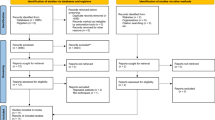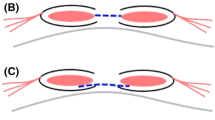Abstract
Purpose
This study reviewed the literature regarding mesh migration in abdominal hernia repair. The aim of this study is to interrogate incidence, common type of abdominal hernia repair leading to migration, patterns of mesh migration, and materials associated with migration.
Methods
A comprehensive literature review was conducted. PubMed and MEDLINE were searched for relevant articles in the English literature. We employed Ovid syntax from 1949 to January 2010, the Cochrane Library, Google and Google Scholar. The clinical trial database Clinicaltrials.gov was reviewed. Letters to the editor were reviewed to extract cross-references. Multiple keywords were used alone and in combination to extract all relevant articles.
Results
In total, 287 unique English citations were reviewed. Of these, 84 articles were selected and consisted of 3 case series, 77 case reports, 2 literature reviews, 1 retrospective study, and 1 prospective, observational study. In an analysis of available cases, the average age was 59.8 ± 13.8 years with a male predominance (76.2%). The index hernia repair was inguinal in 62.9%, incisional/ventral in 28.1%, umbilical in 6.7%, and other in 2.2%. Within the inguinal hernia group, 51.8% were open repairs, 42.9% were laparoscopic, and 1.8% were robotic. Implicated mesh materials included polypropylene, PTFE, and composite mesh. Migration commonly affected multiple organs (31.5%).
Conclusions
It is likely that more cases of mesh migration will appear in the literature. Reports are heterogeneous and highlight the diversity of this complication. A standardized method of reporting is needed to develop guidelines and recommendations for this presentation.






Similar content being viewed by others
References
Dabbas N et al (2011) Frequency of abdominal wall hernias: is classical teaching out of date? JRSM Short Rep 2(1):5
Rutkow IM (1998) Epidemiologic, economic, and sociologic aspects of hernia surgery in the United States in the 1990s. Surg Clin North Am 78(6):941 –941 51, v-vi
Rutkow IM (1997) Surgical operations in the United States. Then (1983) and now (1994). Arch Surg 132(9):983–990
Rutkow IM (2003) Demographic and socioeconomic aspects of hernia repair in the United States in 2003. Surg Clin North Am 83(5):1045–1051
Shouldice EB (2003) The Shouldice repair for groin hernias. Surg Clin North Am 83(5):1163–1187, vii
Burger JW et al. (2004) Long-term follow-up of a randomized controlled trial of suture versus mesh repair of incisional hernia. Ann Surg 240(4): 578–583 (discussion 583-5)
Arroyo A et al (2001) Randomized clinical trial comparing suture and mesh repair of umbilical hernia in adults. Br J Surg 88(10):1321–1323
Luijendijk RW et al (2000) A comparison of suture repair with mesh repair for incisional hernia. N Engl J Med 343(6):392–398
Aldridge AJ, Nehra D (2001) Mesh compared with non-mesh methods of open groin hernia repair: systematic review of randomized controlled trials and laparoscopic compared with open methods of groin hernia repair: systematic review of randomized controlled trials. Br J Surg 88(3):471
Amid PK, Shulman AG, Lichtenstein IL (1994) A critical evaluation of the Lichtenstein tension-free hernioplasty. Int Surg 79(1):76–79
Fitzgibbons RJ Jr, Forse RA (2015) Clinical practice. Groin hernias in adults. N Engl J Med 372(8):756–763
Berger RL et al (2014) Suture versus preperitoneal polypropylene mesh for elective umbilical hernia repairs. J Surg Res 192(2):426–431
Ghanim A et al (2017) Mesh Migration into the j-pouch in a patient with post-ulcerative colitis colectomy: a case report and literature review. Case Rep Surg 2017:3617476
Hume RH, Bour J (1996) Mesh migration following laparoscopic inguinal hernia repair. J Laparoendosc Surg 6(5):333–335
Chuback JA et al (2000) Small bowel obstruction resulting from mesh plug migration after open inguinal hernia repair. Surgery 127(4):475–476
Dieter RA Jr (1999) Mesh plug migration into scrotum: a new complication of hernia repair. Int Surg 84(1):57–59
Xue TM et al (2015) Mesh erosion causes small bowel obstruction: a rare complication of laparoscopic inguinal hernia repair: case description and review of literature. Hepatogastroenterology 62(137):55–58
Celik A et al (2005) Colonoscopic removal of inguinal hernia mesh: report of a case and literature review. J Laparoendosc Adv Surg Tech A 15(4):408–410
Agrawal A, Avill R (2006) Mesh migration following repair of inguinal hernia: a case report and review of literature. Hernia 10(1):79–82
Goswami R, Babor M, Ojo A (2007) Mesh erosion into caecum following laparoscopic repair of inguinal hernia (TAPP): a case report and literature review. J Laparoendosc Adv Surg Tech A 17(5):669–672
Hinojosa MW, Wright AS, Oelschlager BK (2015) The use of mesh in hiatal hernia repair. In: Antireflux surgery. Springer, New York
Pfluke JM et al (2012) Use of mesh for hiatal hernia repair: a survey of SAGES members. Surg Endosc 26(7):1843–1848
Kohn GP et al (2018) Guidelines for the management of hiatal hernia. [Webpage]. Available at: https://www.sages.org/publications/guidelines/guidelines-for-the-management-of-hiatal-hernia/. Accessed 6 Aug 2018
Kocot A, Gerharz EW, Riedmiller H (2011) Urological complications of laparoscopic inguinal hernia repair: a case series. Hernia 15(5):583–586
Riaz AA et al (2004) Mesh erosion into the bladder: a late complication of incisional hernia repair. A case report and review of the literature. Hernia 8(2):158–159
Endlich M et al (2015) Implantation of a total abdominal mesh plastic ending up in multiple, lethal right heart injuries. Interact Cardiovasc Thorac Surg 21(1):135–136
Parker SG et al (2017) Nomenclature in abdominal wall Hernias: is It time for consensus? World J Surg 41(10):2488–2491
Lo DJ, Bilimoria KY, Pugh CM (2008) Bowel complications after prolene hernia system (PHS) repair: a case report and review of the literature. Hernia 12(4):437–440
Millas SG, Mesar T, Patel RJ (2015) Chronic abdominal pain after ventral hernia due to mesh migration and erosion into the sigmoid colon from a distant site: a case report and review of literature. Hernia 19(5):849–852
Gandhi D et al (2011) Chronic abdominal pain secondary to mesh erosion into cecum following incisional hernia repair: a case report and literature review. Ann Gastroenterol 24(4):321–324
Jeans S, Williams GL, Stephenson BM (2007) Migration after open mesh plug inguinal hernioplasty: a review of the literature. Am Surg 73(3):207–209
Acar T et al (2002) Enterocutaneous fistula due to polypropylene mesh migration. Ir J Med Sci 171(3):172, 174
HerniaSurge G (2018) International guidelines for groin hernia management. Hernia 22(1):1–165
Ismail W, Agrawal A, Zia MI (2002) Fate of chronically infected onlay mesh in groin wound. Hernia 6(2):79–81
Di Vita G et al (2000) Tension-free hernia repair is associated with an increase in inflammatory response markers against the mesh. Am J Surg 180(3):203–207
Matthews BD et al (2003) Assessment of adhesion formation to intra-abdominal polypropylene mesh and polytetrafluoroethylene mesh. J Surg Res 114(2):126–132
Matthews BD et al (2005) Evaluation of adhesion formation and host tissue response to intra-abdominal polytetrafluoroethylene mesh and composite prosthetic mesh. J Surg Res 123(2):227–234
Harrell AG et al (2006) Prospective evaluation of adhesion formation and shrinkage of intra-abdominal prosthetics in a rabbit model. Am Surg 72(9):808–813 (discussion 813–4)
Gonzalez R et al (2005) Relationship between tissue ingrowth and mesh contraction. World J Surg 29(8):1038–1043
Ferrone R, Scarone PC, Natalini G (2003) Late complication of open inguinal hernia repair: small bowel obstruction caused by intraperitoneal mesh migration. Hernia 7(3):161–162
Ramakrishnan P et al (2016) A single-centre experience of relaparoscopy in complications of laparoscopic inguinal hernia repair-feasibility and outcomes. Surg Endosc 30(6):2308–2314
Shrivastava A et al (2013) Erosion of small intestine with necrotising fasciitis of over lying abdominal wall after expanded poly-tetrafluoroethylene mesh implantation: a rare complication after laparoscopic incisional hernia repair. J Minim Access Surg 9(3):138–140
Ratajczak A et al (2013) Migration of biomaterials used in gastroenterological surgery. Pol Przegl Chir 85(7):377–380
Author information
Authors and Affiliations
Corresponding author
Ethics declarations
Conflict of interest
HC declares no conflict of interest. JW declares no conflict of interest. LT declares no conflict of interest. SH declares no conflict of interest.
Ethical approval
This study is in compliance with ethical standards.
Human and animal rights
This article does not contain any studies with human participants or animals performed by any of the authors.
Informed consent
For this type of study, formal consent is not required.
Additional information
Publisher’s Note
Springer Nature remains neutral with regard to jurisdictional claims in published maps and institutional affiliations.
Electronic supplementary material
Below is the link to the electronic supplementary material.
Rights and permissions
About this article
Cite this article
Cunningham, H.B., Weis, J.J., Taveras, L.R. et al. Mesh migration following abdominal hernia repair: a comprehensive review. Hernia 23, 235–243 (2019). https://doi.org/10.1007/s10029-019-01898-9
Received:
Accepted:
Published:
Issue Date:
DOI: https://doi.org/10.1007/s10029-019-01898-9




